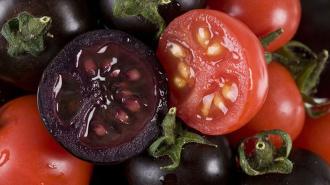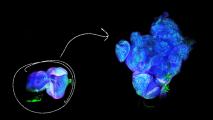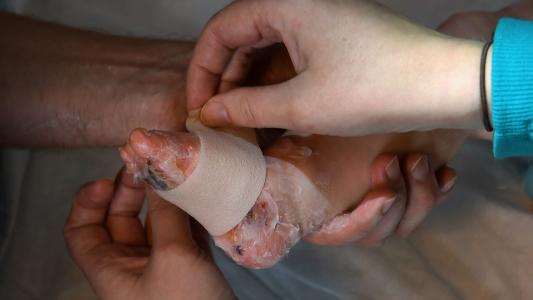Genetically modified purple tomatoes are potentially days away from FDA approval, according to the team that created the colorful fruit. The fruits are modified to be packed with antioxidants.
Purple fruits 101: Antioxidants are chemicals capable of delaying or even preventing certain types of damage to our cells. They can be found in many types of plants, and some studies suggest that eating antioxidant-rich foods can help protect against certain diseases.
Anthocyanins are a type of antioxidant found in high levels in blueberries, blackberries, and plums — they’re what give those fruits their purple hue. Tomatoes also naturally produce anthocyanins, but only in their leaves, not their fruit — at least, until now.
Purple tomatoes: More than a decade ago, Cathie Martin, a plant biologist at the John Innes Center in England, modified a tomato plant to contain two genes from snapdragon plants and one gene from thale cress.
This caused the fruit of the tomato plant to produce anthocyanins and take on their characteristic purple hue.
“They seem to be more resistant to fungal infection, which is what causes tomatoes to rot.”
Cathie Martin
According to a small study Martin published in 2008, cancer-prone mice that were fed a powdered form of the purple tomatoes lived longer than mice that got powder from regular tomatoes.
A follow-up study published in 2013 also found that the purple tomatoes had double the shelf life of unmodified fruits.
“We’re not sure why, but they seem to be more resistant to fungal infection, which is what causes tomatoes to rot,” Martin told the New York Times in July 2021.
“Our ‘business model’ is that we have this tiny company which has no employees.”
Cathie Martin
Small ag: Martin and her colleague Jonathan Jones from the Sainsbury Laboratory formed the company Norfolk Plant Sciences (NPS) to commercialize the purple tomatoes, but applying for FDA approval for a genetically modified food is a costly, complicated process.
“Our ‘business model’ is that we have this tiny company which has no employees,” Martin told the NYT. “Of course, the FDA is used to the bigger organizations, so this is where you get a bit of a problem.”
“When they say, ‘Oh, we want a bit more data on this,’ it’s easy for a corporation,” she says. “For me — it’s me that has to do it! And I can’t just throw money at it.”
After six years, the team’s application is officially under review, with the FDA expected to make a decision by the end of March or in early April 2022. If approved, NPS plans to sell seeds, plants, tomatoes, and tomato products, such as juice.
“We aim to market these tomatoes as nutritionally enhanced, but not with any specific health claims,” said Nathan Pumplin, the company’s president, during an online presentation in February 2022.
The real benefits: The results of mouse studies often don’t translate to people, and it would be almost impossible to prove that purple tomatoes can actually extend our lifespans. People simply live too long for such studies to be logistically feasible.
While there’s nothing unique about the antioxidants in purple tomatoes — you could eat two handfuls of blueberries a day to get the equivalent amount of anthocyanins as the mice in Martin’s study — that would be a lot of blueberries, and the fruit is expensive.
The purple tomatoes’ longer shelf could help reduce food waste.
Tomatoes are comparatively cheap, and they’re easy to grow. According to the U.N. Food and Agriculture Organization (FAO), the world grows 220 times more tomatoes than blueberries by weight. And unlike blueberries, 99% of which are grown in the Americas or Europe, tomatoes are grown the world over.
A person would need to eat just two purple tomatoes a day to get the same amount of antioxidants as two handfuls of blueberries, and that may be less daunting, especially if the tomatoes are made into a sauce. Any type of tomato can be made into a purple tomato without changing its taste, too, which could add some more variety.
Potential health benefits aside, the purple tomatoes’ longer shelf life alone could make them worthwhile, as it could help reduce food waste — but first, the FDA needs to decide in the fruits’ favor.
We’d love to hear from you! If you have a comment about this article or if you have a tip for a future Freethink story, please email us at [email protected].






